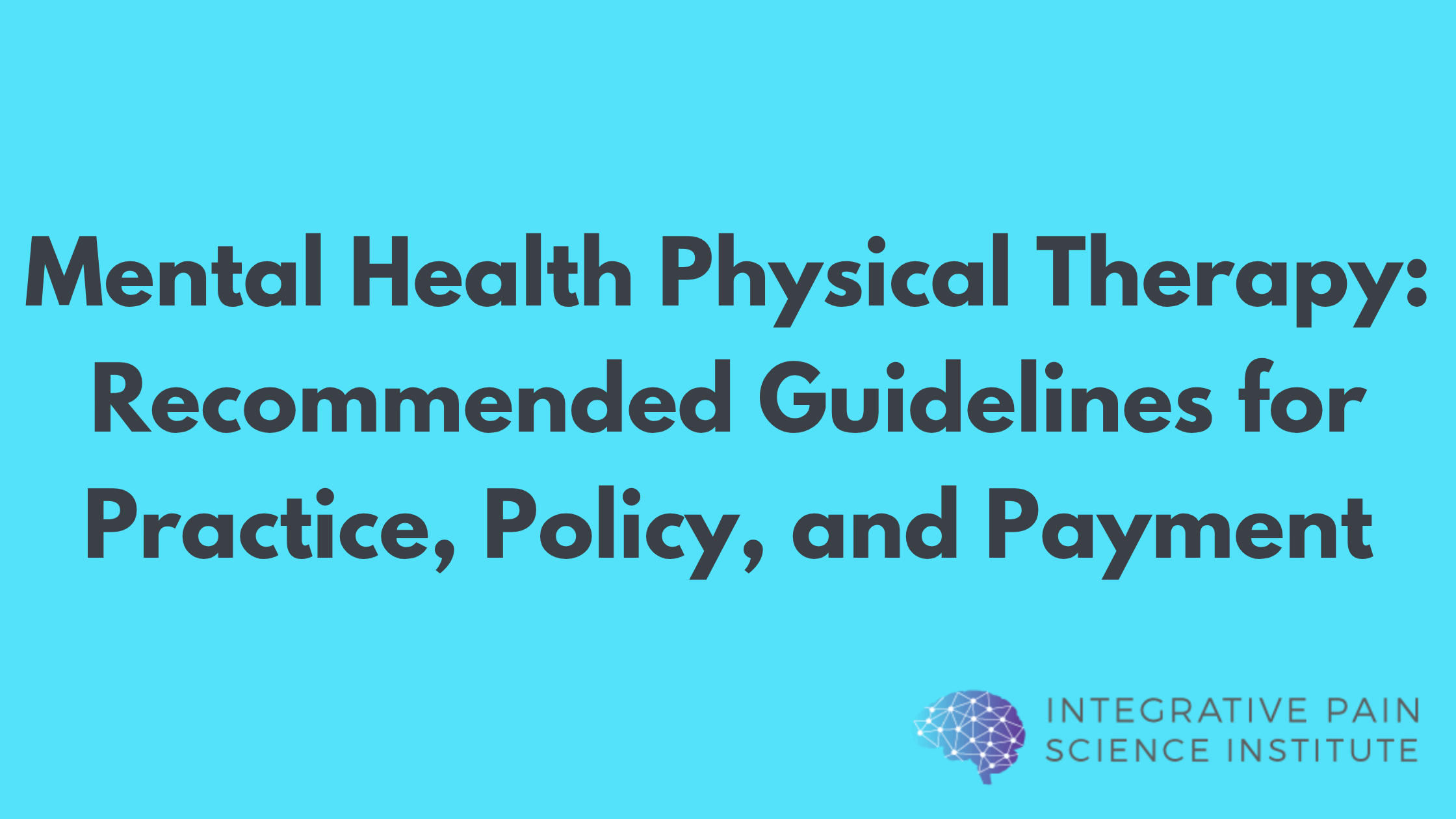Low health literacy has been found to be associated with higher levels of pain intensity (1) as well as decreased health-related knowledge and overall poorer health status (2). Utilization of the biopsychosocial model is the recommended approach for treatment of chronic pain (3). This includes some form of patient education, which can vary widely based on differing treatment approaches. Cognitive Behavioral Therapy (CBT) is designed specifically to reduce pain catastrophizing, which is a negative mind set about actual or anticipated pain (4). Pain catastrophization, as well as fear and anxiety, are strongly correlated to pain and disability (5), making CBT potentially beneficial treatment for those with chronic pain with elements of pain catastrophization.

COMPARING COGNITIVE BEHAVIOURAL THERAPY TO PAIN EDUCATION
A 2011 randomized control trial published in the Journal of Pain sought to compare how the utilization of Cognitive Behavioral Therapy (CBT) versus pain education would influence pain-related outcomes in a population of low socioeconomic status. A total of 61 participants completed the study, all of which had pain lasting for at least 3 months and the majority of participants were part of minority groups. Participants underwent an initial screening, pretreatment assessment, 10 weeks of treatment, a post treatment assessment, and a 6-month follow-up post treatment. Demographics were obtained as well as a pain interview and a literacy and cognitive screening prior to treatment. Outcome measures taken at the pretreatment and posttreatment assessments included the Wisconsin Brief Pain Inventory, Roland-Morris disability scale to measure perceived disability, Pain Catastrophizing Scale, Center for Epidemiological Studies Depression Scale (CES-D), and the Quality of Life Scale.
Participants received treatment sessions consisting of CBT or pain education once a week for a total of 10 treatment sessions. Each session lasted 90 minutes and participants had the opportunity to make up missed sessions if needed. Participants in both groups received materials and handouts related to the treatment they were receiving. Authors Thorn et al. reported the following for each treatment:
CBT treatment focused on “thoughts and feelings in response to pain and stress, and helping participants learn how to manage their thoughts and feelings might improve pain coping” Additionally, homework was assigned in the CBT sessions, but not in the pain education sessions.
Pain Education focused on “learning facts about the body and pain, and helping participants learn these facts might improve pain coping”.

FEASIBILITY & TOLERABILITY OF TREATMENT
Results of the study showed that participants that qualified but did not participate in the treatment sessions overall had fewer years of education, lower reading ability, and high pain catastrophizing scores. This may be due to the lack of understanding the potential benefits of receiving CBT or Pain Education treatment. Additionally, the dropout rate for participants attending the CBT treatment was much higher than patients receiving pain education. This may have been due to the cognitive load of the CBT protocol, suggesting it may have needed further adaptations for this population.
Interestingly, it was found that retention of previous session material was found to be a predictor of dropout. This further supports the notion that any treatment should be individualized and adapted as needed. Additionally, it would be beneficial to ensure that patients are comprehending the information using tools such as the teach-back method.
CBT & PAIN EDUCATION’S ASSOCIATION WITH PAIN
Overall, both CBT and pain education had similar effects on pain-related outcomes. Participants that completed the treatment sessions reported significant improvements in pain intensity and being able to function with pain in both the short-term and long-term. Participants’ reports suggest they were better able to accept their pain and not let it interfere with daily activities as much. It is also important to consider the low health literacy of this population. It is very likely that providing any education would be helpful in helping them to better understand their pain.
Dr. Tatta’s simple and effective pain assessment tools. Quickly and easily assess pain so you can develop actionable solutions in less time.
CBT & PAIN EDUCATION’S ASSOCIATION WITH DEPRESSION & PAIN CATASTROPHIZING
Depressive symptom severity and pain catastrophizing decreased significantly in participants who completed the CBT treatment. It is also important to note that these changes were maintained at the long-term follow up assessment 6 months following treatment. The specific skill building exercises given during the CBT treatment may have increased the treatment gains when compared to pain education alone.

OVERALL TAKEAWAYS
Both CBT and pain education had positive effects on pain-related outcomes for participants who completed the 10-session treatment protocol. Participants who demonstrated a better understanding of material taught during sessions were more likely to complete treatment sessions without dropping out. While the treatments in this study were completed in small groups, it is important to note this finding supports how important it is to provide individualized treatment appropriate for the patient’s current literacy level and readiness to accept treatment. Pain education, cognitive behavioural therapy for chronic pain, and most importantly combined treatments are a best practice for helping people overcome pain and improve patient outcomes.

Shelby McClure is a third year Doctorate of Physical Therapy student at Augusta University in Augusta, Georgia and will be graduating in May of 2020. She completed her undergraduate education at Auburn University in Alabama where she earned a B.S. in Fitness, Conditioning, and Performance in addition to a B.S. in Nutrition and Wellness.
Shelby began dancing at a young age which helped to shape her initial interest in health. During college, she worked as a dance instructor as well as a group fitness instructor, which eventually led her to pursue a career in physical therapy.
Throughout her time at Augusta University and subsequent clinical rotations, Shelby realized her passion for pain science and psychologically informed physical therapy. Shelby is currently completing a 4-week elective with the Integrative Pain Science Institute prior to her graduation.
Shelby is from the Atlanta, Georgia area where she currently resides with her husband of 2 years.
To learn more about Shelby, visit her LinkedIn.
REFERENCES
- Köppen PJ, Dorner TE, Stein KV, Simon J, Crevenna R. Health literacy, pain intensity and pain perception in patients with chronic pain. Wien Klin Wochenschr. 2018;130(1-2):23–30. doi:10.1007/s00508-017-1309-5
- Berkman N D,Sheridan S L,Donahue K E,Halpern J,Crotty K. Low health literacy and health outcomes: an updated systematic review. Ann Intern Med. 2011;155(2):97–107. https://doi.org/10.7326/0003-4819-155-2-20110719000005.
- Scottish Intercollegiate Guidelines Network. Management of chronic pain: SIGN publication no.136. Edinburgh2013.
- Sullivan MJ, Thorn BE, Haythornthwaite JA, Keefe F, Martin M, Bradley LA, Lefebvre JC. Theoretical perspectives on the relation between catastrophizing and pain. Clinical J Pain. 2001; 17:52–64. [PubMed: 11289089]
- Louw, A., Schmidt, S., Puentedura, E. and Zimney, K., 2018. Pain Neuroscience Education. 2nd ed. Minneapolis, MN: OPTP, pp.1-30.
- Thorn BE, Day MA, Burns J, et al. Randomized trial of group cognitive behavioral therapy compared with a pain education control for low-literacy rural people with chronic pain. Pain. 2011;152(12):2710–2720. doi:10.1016/j.pain.2011.07.007



